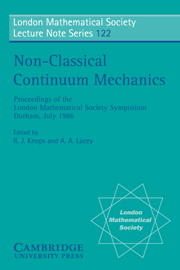 Non-Classical Continuum Mechanics
Non-Classical Continuum Mechanics Published online by Cambridge University Press: 11 May 2010
INTRODUCTION
This paper discusses certain types of stability questions that have been largely ignored in the literature, i.e. continuous dependence on geometry and continuous dependence on modeling. Although we shall consider these questions primarily in the context of ill-posed problems we shall briefly indicate some difficulties that might arise under geometric and/or modeling perturbations in well posed problems.
In setting up and analyzing a mathematical model of any physical process it is inevitable that a number of different types of errors will be introduced e.g. errors in measuring data, errors in determining coefficients, etc. There will also be errors made in characterizing the geometry and in formulating the mathematical model. In most standard problems the errors made will induce little error in the solution itself, but for ill-posed problems in partial differential equations this is no longer true.
Throughout this paper we shall assume that a “solution” to the problem under consideration exists in some accepted sense, but in the case of ill-posed problems such a “solution” will invariably fail to depend continuously on the data and geometry. We must appropriately constrain the solution in order to recover the continuous dependence (see [8]); however, appropriate restrictions are often difficult to determine. In the first place any such constraint must be both mathematically and physically realizable. At the same time a given constraint must simultaneously stabilize against all possible errors that may be made in setting up the mathematical model of the physical problem. Since a constraint restriction has the effect of making an otherwise linear problem nonlinear, one must use care in treating the various errors separately and superposing the effects.
To save this book to your Kindle, first ensure [email protected] is added to your Approved Personal Document E-mail List under your Personal Document Settings on the Manage Your Content and Devices page of your Amazon account. Then enter the ‘name’ part of your Kindle email address below. Find out more about saving to your Kindle.
Note you can select to save to either the @free.kindle.com or @kindle.com variations. ‘@free.kindle.com’ emails are free but can only be saved to your device when it is connected to wi-fi. ‘@kindle.com’ emails can be delivered even when you are not connected to wi-fi, but note that service fees apply.
Find out more about the Kindle Personal Document Service.
To save content items to your account, please confirm that you agree to abide by our usage policies. If this is the first time you use this feature, you will be asked to authorise Cambridge Core to connect with your account. Find out more about saving content to Dropbox.
To save content items to your account, please confirm that you agree to abide by our usage policies. If this is the first time you use this feature, you will be asked to authorise Cambridge Core to connect with your account. Find out more about saving content to Google Drive.